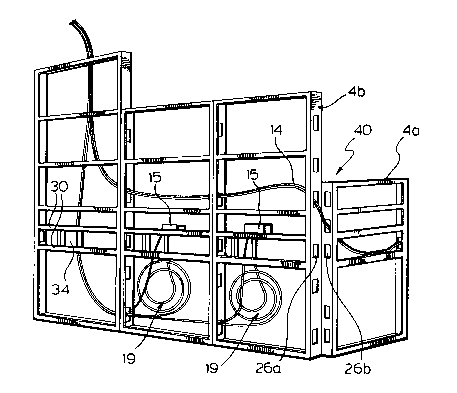Some of the information on this Web page has been provided by external sources. The Government of Canada is not responsible for the accuracy, reliability or currency of the information supplied by external sources. Users wishing to rely upon this information should consult directly with the source of the information. Content provided by external sources is not subject to official languages, privacy and accessibility requirements.
Any discrepancies in the text and image of the Claims and Abstract are due to differing posting times. Text of the Claims and Abstract are posted:
| (12) Patent: | (11) CA 2014702 |
|---|---|
| (54) English Title: | COMBINED FIBER OPTIC CONDUITS AND OFFICE PANEL |
| (54) French Title: | CONDUITS A FIBRES OPTIQUES ET PANNEAUX DE BUREAU COMBINES |
| Status: | Expired and beyond the Period of Reversal |
| (51) International Patent Classification (IPC): |
|
|---|---|
| (72) Inventors : |
|
| (73) Owners : |
|
| (71) Applicants : |
|
| (74) Agent: | SMART & BIGGAR LP |
| (74) Associate agent: | |
| (45) Issued: | 1995-12-12 |
| (22) Filed Date: | 1990-04-17 |
| (41) Open to Public Inspection: | 1991-10-17 |
| Examination requested: | 1993-04-13 |
| Availability of licence: | N/A |
| Dedicated to the Public: | N/A |
| (25) Language of filing: | English |
| Patent Cooperation Treaty (PCT): | No |
|---|
| (30) Application Priority Data: | None |
|---|
An office panelling system is advantageously
combined with fiber optic communication cable wherein the
panels of the system are generally open in the center
thereof and the vertical space of the panel is
advantageously used for reducing the curvature of the cable
between panels disposed at an angle. The panels have a
metal framework onto the sides of which cover members are
secured such that the interior of the framework is generally
open. The framework includes a host of distributed passage
ports therethrough for allowing communication cables and the
like to pass through the framework where desired. The fiber
optic communication cable is strung through the frameworks
of the panels and rounds corners between panels disposed at
an angle by using both the vertical and horizontal planes of
the framework to provide a curvature in the cable rounding
the corner between angled panels much greater than the angle
of curvature of the cable if the cable was confined to a
single horizontal plane for rounding the same corner. The
rate of curvature of the cable is important, as in fiber
optic cables light loss is encountered with any corner and
the extent of the light loss increases as the radius of
curvature becomes smaller. It is the general practice that
the rate of curvature should not be less than ten times the
diameter of the cable.
Note: Claims are shown in the official language in which they were submitted.
Note: Descriptions are shown in the official language in which they were submitted.

2024-08-01:As part of the Next Generation Patents (NGP) transition, the Canadian Patents Database (CPD) now contains a more detailed Event History, which replicates the Event Log of our new back-office solution.
Please note that "Inactive:" events refers to events no longer in use in our new back-office solution.
For a clearer understanding of the status of the application/patent presented on this page, the site Disclaimer , as well as the definitions for Patent , Event History , Maintenance Fee and Payment History should be consulted.
| Description | Date |
|---|---|
| Time Limit for Reversal Expired | 2008-04-17 |
| Letter Sent | 2007-04-17 |
| Inactive: IPC from MCD | 2006-03-11 |
| Revocation of Agent Requirements Determined Compliant | 2000-07-10 |
| Appointment of Agent Requirements Determined Compliant | 2000-07-10 |
| Inactive: Office letter | 2000-07-10 |
| Inactive: Office letter | 2000-07-10 |
| Inactive: Late MF processed | 2000-06-14 |
| Letter Sent | 2000-04-17 |
| Letter Sent | 1999-06-15 |
| Inactive: Multiple transfers | 1999-05-10 |
| Inactive: Adhoc Request Documented | 1998-04-17 |
| Letter Sent | 1997-04-17 |
| Grant by Issuance | 1995-12-12 |
| All Requirements for Examination Determined Compliant | 1993-04-13 |
| Request for Examination Requirements Determined Compliant | 1993-04-13 |
| Application Published (Open to Public Inspection) | 1991-10-17 |
There is no abandonment history.
| Fee Type | Anniversary Year | Due Date | Paid Date |
|---|---|---|---|
| MF (patent, 8th anniv.) - standard | 1998-04-17 | 1998-04-15 | |
| MF (patent, 9th anniv.) - standard | 1999-04-19 | 1999-03-15 | |
| Registration of a document | 1999-05-10 | ||
| MF (patent, 10th anniv.) - standard | 2000-04-17 | 2000-06-14 | |
| Reversal of deemed expiry | 2000-04-17 | 2000-06-14 | |
| MF (patent, 11th anniv.) - standard | 2001-04-17 | 2001-04-10 | |
| MF (patent, 12th anniv.) - standard | 2002-04-17 | 2002-04-15 | |
| MF (patent, 13th anniv.) - standard | 2003-04-17 | 2003-04-10 | |
| MF (patent, 14th anniv.) - standard | 2004-04-19 | 2004-03-08 | |
| MF (patent, 15th anniv.) - standard | 2005-04-18 | 2005-04-13 | |
| MF (patent, 16th anniv.) - standard | 2006-04-18 | 2006-04-12 |
Note: Records showing the ownership history in alphabetical order.
| Current Owners on Record |
|---|
| TEKNION FURNITURE SYSTEMS LIMITED |
| Past Owners on Record |
|---|
| JOHN HELLWIG |